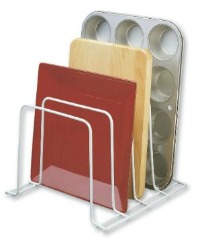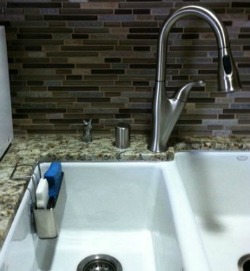Instead, the purpose of organizing this area of your home is to allow you to easily access what you need for cooking or other kitchen activities when you need those items. With that in mind you can make good decisions about functionality and organization to suit your family's needs without making more work for yourself than you need to.
Declutter The Stuff You Shouldn't Have In Your House Anymore At All
The first part of the kitchen cabinet organization challenge's decluttering phase is to remove all the stuff from your kitchen drawers and cabinets that should not be in your house anymore. These items should be thrown away or donated to charity.Here are examples of these types of items:
- Broken items - but I will fix them LOL
- Duplicates - hmmmmmmmm but I like 5 rubber spatulas
- Excess items (like too many coffee mugs, or plastic drinking glasses) can you really have too many -- this is truly going to be a challenge
- Oprhaned lids or containers with missing lids - :)
- Things you never use (because they are ugly, don't work well, you don't really like them, etc.)
- Things you haven't used in the last year, at least - but there are somethings that I will want to keep .. now to think it through will I use or wont I
Sort What Is Left According To How Often You Use It
The third step in the Kitchen Cabinet Organization Challenge is to sort the items you've decided to keep in your home, and will most likely stay in the kitchen, into one of three types.- Items used everyday
- Items used often (once every couple of days to every couple of weeks)
- Items used seldomly
 One of the simplest ways to do this is to think of your kitchen in terms of "zones" or areas of use. Then, make sure you keep the stuff close to where you'll use it. For example, pots and pans should be close to the stove, and the paring knife should be close to the kitchen sink and cutting board.
One of the simplest ways to do this is to think of your kitchen in terms of "zones" or areas of use. Then, make sure you keep the stuff close to where you'll use it. For example, pots and pans should be close to the stove, and the paring knife should be close to the kitchen sink and cutting board.Here are some common kitchen zones you should consider using, and the items that should be in them. (Please note that there will be some overlap between zones so don't get too caught up in splitting zones up, versus what works for you. Further, your kitchen layout may not be ideal, so just do the best you can with what you've got. Just thinking it through can improve the space you've got to work in dramaticaly, even if it isn't "perfect" or doesn't exactly follow the rules below.)
cooking sheets for easier
access
Food Preparation Zone
The food prep zone is the area where you cut, chop, clean, mix, stir, etc. the food you are preparing. This area needs some open counterspace, and most likely will be close to the sink.You should keep items such as your knives, cutting board, mixing bowls, mixers and blenders, measuring cups and spoons in this zone.
Cooking Zone
The cooking zone is where you do your cooking, either on the stove or in the oven (or microwave). It should therefore be close to these appliances.You should keep items such as pots and pans, cooking utensils, potholders and bakeware in this zone.
Dishes And Dishwashing Zone

keeping dishwashing zone organizedThe dishes and dishwashing zone is the area where you keep your everyday dishes and eating utensils.
This area should be close to the dishwasher and/or sink for ease of cleaning up and putting everything back away after use. You should also keep dishwashing supplies in this area, or in a sub-zone of this area, such as dish soap, sponges, dish cloths, etc.
Please note that if you've got children it is a good idea to have a special section, within their reach, for certain types of dishes, such as non-breakable cups or bowls so they can get themself a drink or water or a bowl of cereal for breakfast without your assistance. Trust me, it will save your sanity to have this easy access area for them, and will be worth the time invested in the whole Kitchen Cabinet Organization Challenge!
In addition, if you want your kids to set the table or put away dishes from the dishwasher, make sure they can reach these items without difficulty or you won't be able to assign them these chores.
Eating Zone
The eating zone should contain things you use on a regular basis for eating meals, such as tablecloths, napkins, salt and pepper shakers, serving bowls or platters, etc. It could also contain bibs for the baby.Please note that the serving bowls and platters I'm referring to for this zone should be things you use regularly, not the ones you use only on special or holiday occassions.
Idealy the items for this zone should be stored close to the kitchen table, or dining room table, whichever you normally eat your meals at.
Food Storage Zone
We will focus on the food storage zone in the next couple of weeks of the challenge, so don't start tackling it just yet during the Kitchen Cabinet Organization Challenge this week. However, if you don't have a dedicated pantry, you may need to save some space in your cabinets or cupboards for some food storage so I mention it now just so you can keep it in mind.Further, a non-food item that does belong near the food storage zone are the supplies you use for saving leftovers, such as aluminum foil, plastic baggies, and kitchen wrap, and you may wish to organize those types of items this week as well.
That concludes the main zones in the kitchen. Really think through where stuff should ideally go in your kitchen based on those zones and shift things around until they make sense, and fit in the space alotted. This step of the Kitchen Drawers and Kitchen Cabinet Organization Challenge is what will make your kitchen feel functional, and end up saving you a lot of time, since things will be easier for you to use when needed.
I also thought I would give special attention to three common areas in our kitchens that can be organizational challenges, so you can think through how you'll handle them as part of the Kitchen Drawers And Kitchen Cabinet Organization Challenge
****I am truly glad that I read this before I started the decluttering :) It makes throwing away and moving things a lot easier :)

No comments:
Post a Comment